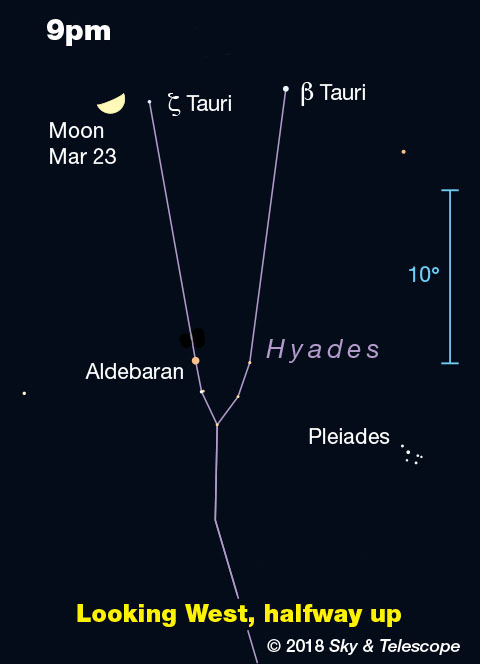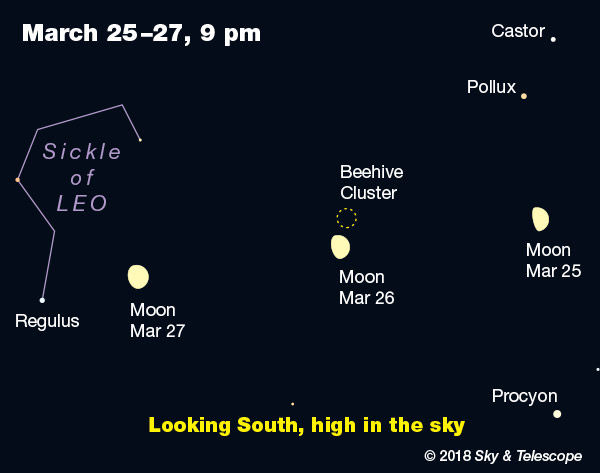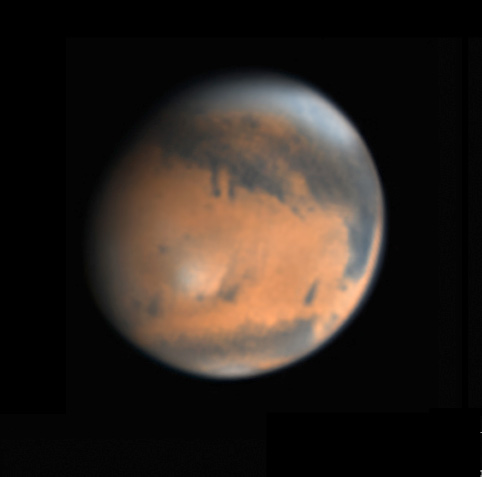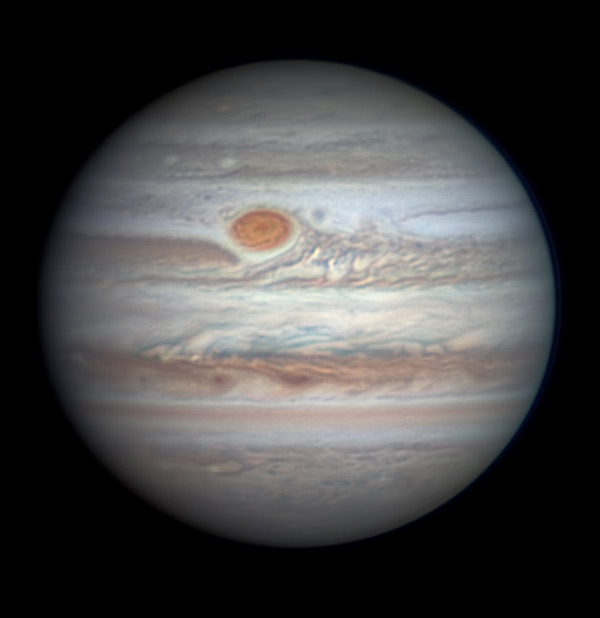
Friday, March 23
• The Moon stands at the horntips of Taurus tonight, as shown at right. Traditional portrayals of Taurus show the Bull with remarkably long horns. Aldebaran and the brightest Hyades stars are supposed to represent his fiery eye and V-shaped face.
Lower left of the Moon you'll find Betelgeuse, out of the picture here.
More than twice as far to the Moon's right or upper right shines Capella.
• Now that it's spring, the signature fall-and-winter constellation Cassiopeia retreats downward after dark. But for skywatchers at mid-northern latitudes Cassiopeia is circumpolar, never going away completely. Look for it fairly low in the north-northwest these evenings. It's still standing nearly on end. By 2 a.m. it's at its lowest due north, lying not quite horizontally.

Saturday, March 24
• First-quarter Moon (exact at 11:35 a.m. EDT). This evening the Moon shines high above Orion, in the feet of Gemini below Castor and Pollux.
Sunday, March 25
• At dusk, look above the Moon for Pollux (with Castor), and look farther below the Moon for Procyon. The Moon is 1.3 light-seconds from Earth — compared to Procyon's distance of 11 light-years, Pollux at 34 light-years, and Castor at 52.
• Meanwhile Arcturus, the "Spring Star," now rises above the east-northeast horizon around the time the stars come out. How soon can you spot it?
Monday, March 26
• This is the time of year when the dim Little Dipper juts to the right from Polaris (the Little Dipper's handle-end) during late evening. The much brighter Big Dipper curls over high above it, "dumping water" into it. They do the reverse water-dump in the fall.
Tuesday, March 27
• Look lower left of the Moon this evening for Regulus, the brightest star of Leo and the bottom of Leo's Sickle: a backward question mark about a fist at arm's length tall.
Wednesday, March 28
• Now Regulus shines to the Moon's upper right after dark.
Thursday, March 29
• Before the first hint of dawn tomorrow morning, meaning at least 90 minutes before your local sunrise time, spot Mars and Saturn glowing just 2° apart in the south-southeast. They're above the Sagittarius Teapot. Just below the two planets, almost forming an equilateral triangle with them, binoculars will show the big globular cluster M22, "the M13 of the south."
Friday, March 30
• After nightfall, Orion is still well up in the southwest in his spring orientation: striding down to the right, with his belt horizontal. The belt points left toward bright Sirius, and right toward orange Aldebaran and, farther on, the Pleiades.
Saturday, March 31
• Full Moon (exact at 8:37 a.m. EDT). This evening, look lower right of the Moon for Spica and three times farther left of the Moon for brighter Arcturus.
________________________
Want to become a better astronomer? Learn your way around the constellations! They're the key to locating everything fainter and deeper to hunt with binoculars or a telescope.
This is an outdoor nature hobby. For an easy-to-use constellation guide covering the whole evening sky, use the big monthly map in the center of each issue of Sky & Telescope, the essential guide to astronomy.

Once you get a telescope, to put it to good use you'll need a detailed, large-scale sky atlas (set of charts). The basic standard is the Pocket Sky Atlas (in either the original or Jumbo Edition), which shows stars to magnitude 7.6.
Next up is the larger and deeper Sky Atlas 2000.0, plotting stars to magnitude 8.5; nearly three times as many. The next up, once you know your way around, is the even larger Uranometria 2000.0 (stars to magnitude 9.75). And read how to use sky charts with a telescope.
You'll also want a good deep-sky guidebook, such as Sue French's Deep-Sky Wonders collection (which includes its own charts), Sky Atlas 2000.0 Companion by Strong and Sinnott, or the bigger Night Sky Observer's Guide by Kepple and Sanner.
Can a computerized telescope replace charts? Not for beginners, I don't think, and not on mounts and tripods that are less than top-quality mechanically (meaning heavy and expensive). And as Terence Dickinson and Alan Dyer say in their Backyard Astronomer's Guide, "A full appreciation of the universe cannot come without developing the skills to find things in the sky and understanding how the sky works. This knowledge comes only by spending time under the stars with star maps in hand."
This Week's Planet Roundup


Mercury is rapidly fading and sinking away in the afterglow of sunset. Using binoculars on the 23nd and 24th, can you still pick up Mercury in bright twilight 6° or 7° to the lower right of Venus? Mercury is only 2nd magnitude now.
Venus (magnitude –3.9) shines low due west in twilight.
Mars and Saturn, together in Sagittarius, rise around 2 or 3 a.m. daylight-saving time. At the beginning of dawn, they're the two bright points close together in the south-southeast, above the fainter Sagittarius Teapot. They're almost equally bright (about magnitude +0.5), but Mars is redder.
Mars continues to draw closer to Saturn. The gap between them shrinks from 5° on the morning of March 24th to 1.3° when they pass each other on April 2nd.
Far to their right at the beginning of dawn is Antares, and farther right is bright Jupiter.
Jupiter (magnitude –2.4, in Libra) rises around 11 p.m. daylight-saving time and shines as the brightest point in the late-night sky. It's highest in the south, presenting the sharpest views in a telescope, around 3 or 4 a.m., well before dawn.
Uranus and Neptune are buried in the glare of the Sun.
______________________
All descriptions that relate to your horizon — including the words up, down, right, and left — are written for the world's mid-northern latitudes. Descriptions that also depend on longitude (mainly Moon positions) are for North America.
Eastern Daylight Time (EDT) is Universal Time (also called UT, UTC, GMT, or Z time) minus 4 hours.
______________________
"Remember to look up at the stars and not down at your feet. Try to make sense of what you see and wonder about what makes the universe exist. Be curious."
— Stephen Hawking, 1942–2018
______________________
"The dangers of not thinking clearly are much greater now than ever before. It's not that there's something new in our way of thinking, it's that credulous and confused thinking can be much more lethal in ways it was never before."
— Carl Sagan, 1996
______________________
"Objective reality exists. Facts are often determinable. Vaccines save lives. Carbon dioxide warms the globe. Bacteria evolve to thwart antibiotics, because evolution. Science and reason are not a liberal conspiracy. They are how we determine facts. Civilization's survival depends on our ability, and willingness, to do so."
— Alan MacRobert, your Sky at a Glance editor
______________________
"Facts are stubborn things."
— John Adams, 1770
 0
0








Comments
You must be logged in to post a comment.